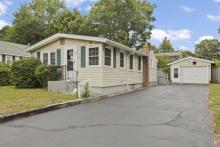Historical records reveal traces of lost Native American churches
Dartmouth might be known as a home of Quakers, but there is another religious significance in the town’s early history: Native American churches.
It’s a topic historian Richard W. Gifford has done extensive research into, as written records of these churches – and the worship that went on inside them – is scarce. Gifford shared some of his research to a packed room at a Dartmouth Historical and Arts Society lecture recently.
Much of Gifford’s knowledge comes from court records, which include testimony from early Dartmouth settlers about the locations, names, and activities of several churches both in modern day Dartmouth and “Old Dartmouth.”
It is believed one such settlement was once called “Quanachee,” and was located south of Russells Mills Village in the area of Dartmoor Farm and Slocum’s River Reserve.
Narratives of this site come from testimony given in court in 1859. A group of Native Americans had attempted to claim large swaths of land on the western shore of the Slocum’s River as theirs under hereditary descent.
Charlotte Smith, who herself was Native American, testified in that case that the burial ground existed between a property owned by Samuel Barker and the Slocum’s River. Another woman said she remembered some of the Native American people living on the west side of the river.
Marlborough Wood, who was 91 at the time of his testimony, remembered large numbers of Native Americans occupying both sides of the Slocum’s River in his childhood.
Wood remembered Native American pastor Nehemiah Abel living in the area of Barker’s farm. Wood told of Abel having an orchard on Barker’s farm, and said Abel hosted Native Americans from Martha’s Vineyard and other areas of the state for a yearly sacrament.
Gifford also discussed two other churches in the region. He highlighted a church once located on John Dyer Road in Little Compton. Native American John Simon served as pastor there. In a pamphlet written by William Emerson -- father of Ralph Waldo Emerson -- he described Simon as “a man of strong mind, prevailingly temperate, but occasionally devious.”
The third church Gifford researched was the Acoaxet in Westport, located on Old Harbor Rd.
Outside of the churches existing and the names of some of its pastors, not much else is known.
Gifford said historical documentation about the specific denominations of the churches is lacking, although some of the Native Americans noted as being pastors were described as baptists.












